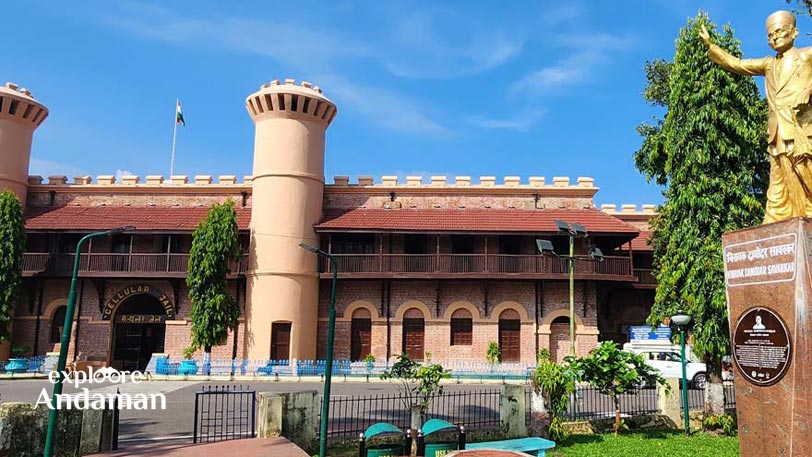Cellular Jail - Biog of freedom fighters at Andaman
Constructed between 1896 and 1906, Cellular Jail, also known as Kala Pani, served as a prison in India during British rule. The intention was to prevent all of the Indian independence activists from spreading their ideas and ideologies on the mainland. Roughly 200 activists were brought here following the 1857 Indian Rebellion. The activists had to be kept away from the mainland, hence these islands were necessary. The prison was known as "cellular" because solitary confinement was intended for each cell. It was notorious for its harsh circumstances and used to punish political prisoners.

Architecture of Cellular Jail
The Cellular Prison is a hexagonal building with seven outward-pointing wings that branch off a central tower. There were 698 cells utilized for solitary confinement in each of the three-story wings. There was very little ventilation in the tiny, gloomy chambers. Other harsh elements of the jail's architecture were punishment cells, a dark cell, and a cell for condemned inmates. The location of the former national memorial for the prisoners of freedom is now the site of a brand-new building.
Punishments at Cellular Jail
The cellular prison had a second bad reputation for punishing political prisoners severely. Some of the punishments included:
- Solitary confinement: The cells were designed specifically for solitary confinement, which was intended to break the prisoners' spirits.
- Hard labour: Prisoners were had to perform hard labour, which included moving large objects, breaking rocks, and constructing roads.
- Chains and shackles: Prisoners frequently had chains and shackles around their bodies, making it difficult for them to move or work.
- Floggings: Flogging was a common method of punishing inmates that frequently led to life-threatening injuries.
- Dark cells: Prisoners were kept in cramped, dim, windowless cells with no lighting.
- Punishment cells: Prisoners were housed in punishment cells, which were even more cramped and compact than the standard cells.
- Death penalty: Inmates who had been given hanging death sentences were executed there.
The goal of these penalties was to break the captives' morale and quell any political resistance. The Indian National Congress and other freedom fighters strongly opposed these severe penalties, which had a big impact on the drive for Indian independence.
Prisoners in Cellular Jail
During the British colonial era in India, political prisoners were housed in the Cellular Prison. There were several prominent members of the Indian independence movement were detained. The following are some of the most well-known detainees of the Cellular Jail:
- Vinayak Damodar Savarkar was a liberation warrior, author, and philosopher who was imprisoned for life after being charged with taking part in the murder of a British officer.
- Batukeshwar Dutt: A revolutionary who was imprisoned for life after being captured alongside Bhagat Singh for tossing bombs into the British parliament.
- Yogendra Shukla, a revolutionary from India and close friend of Bhagat Singh, was detained and imprisoned in the Cellular jail.
- Mahavir Singh was a revolutionary from India who was detained and imprisoned in cells for several years.
- Rash Behari Bose: He was an Indian revolutionary who was detained and imprisoned for several years in the Cellular jail.
- Barindra Kumar Ghose, an Indian revolutionary and Subhas Chandra Bose's older brother, was detained and imprisoned at the Cellular prison.
Although these political prisoners and numerous other freedom fighters endured harsh treatment and deplorable conditions in the Cellular Prison, their sacrifices and fight for independence served as an inspiration for many more to join the freedom movement.
Post-Independence, Cellular Jail
The Cellular Prison, popularly known as Kala Pani, was no longer in service as a prison after India attained independence from British colonial rule in 1947. The British government destroyed the prison in the 1930s, and the remaining structures were put to use for a variety of uses. Afterward, the Indian government made the decision to turn it into a national memorial in honor of the freedom fighters who gave their lives there while they were detained.
On February 11, 1979, Morarji Desai, India's then-prime minister, proclaimed Cellular Prison a National Monument. The original Cellular Prison was demolished and replaced with a modern building that now functions as a museum and a memorial. Photographs and other historical relics connected to the prison and the Indian independence movement are on display there. Along with learning about the jail's history and the lives of the political prisoners who were housed there, visitors can also take a tour of the facility.
Light and Sound Show
The Cellular Jail is now a well-liked tourist attraction and has a nightly Light and Sound Show. A combination of music and light elements is used in the performance to reflect the jail's history as well as the struggle of the Indian freedom fighters who were housed there.
A brief background to the jail's construction and history precedes the show. After then, it walks the spectator through the jail's history, emphasizing the harsh treatment of the inmates and their struggles to survive in the impoverished surroundings.
The show's sound and lighting elements are intended to have an intensely dramatic and emotional effect on the audience. It also pays homage to the valiant freedom warriors who suffered and gave their lives to advance India's independence.
Overall, the Cellular Jail's light and sound show is a fantastic way to learn about the fascinating tales of the Indian independence fighters who were imprisoned there as well as the history of this famous institution. Everyone visiting the Andaman and Nicobar Islands must check it out.